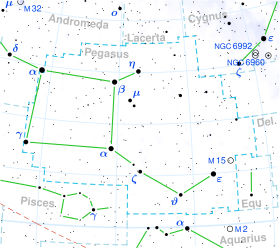Single star in the constellation Pegasus
For other stars with this Bayer designation see π Pegasi
π Pegasi , Latinized as Pi Pegasi , is a single star in the northern constellation Pegasus . It is yellow-white in hue and visible to the naked eye as a faint point of light with an apparent visual magnitude of +4.28. The distance to this object is approximately 263 light years based on parallax , and it is drifting further away with a radial velocity of +5 km/s. This star is an outlying member of the Ursa Major Moving Group .
π Pegasi (right) and π Pegasi (left) in optical light This object has a stellar classification of F5 III, matching an aging giant star that has exhausted the supply of hydrogen at its core then cooled and expanded off the main sequence . At present it has 8.5 times the radius of the Sun . The star is 530 million years old with 2.48 times the Sun's mass . It shows a high rotation rate considering its evolutionary status, with a projected rotational velocity of 140 km/s. The star has been noted as a possible variable shell star . Pi Pegasi is radiating 103 times the Sun's luminosity from its swollen photosphere at an effective temperature of 6,300 K.
References
^ van Leeuwen, F. (November 2007), "Validation of the new Hipparcos reduction", Astronomy and Astrophysics , 474 (2): 653–664, arXiv :0708.1752 , Bibcode :2007A&A...474..653V , doi :10.1051/0004-6361:20078357 , S2CID 18759600
^ Anderson, E.; Francis, Ch. (2012), "XHIP: An extended hipparcos compilation", Astronomy Letters , 38 (5): 331, arXiv :1108.4971 , Bibcode :2012AstL...38..331A , doi :10.1134/S1063773712050015 , S2CID 119257644 .
^ Herbig, George H.; Spalding, John F. Jr. (January 1955), "Axial Rotation and Line Broadening in Stars of Spectral Types F0-K5", Astrophysical Journal , 121 : 118, Bibcode :1955ApJ...121..118H , doi :10.1086/145969 .
^ Reiners, Ansgar (January 2006), "Rotation- and temperature-dependence of stellar latitudinal differential rotation", Astronomy and Astrophysics , 446 (1): 267–277, arXiv :astro-ph/0509399 , Bibcode :2006A&A...446..267R , doi :10.1051/0004-6361:20053911 , S2CID 8642707
^ Luck, R. Earle (September 2015), "Abundances in the Local Region. I. G and K Giants", The Astronomical Journal , 150 (3): 23, arXiv :1507.01466 , Bibcode :2015AJ....150...88L , doi :10.1088/0004-6256/150/3/88 , S2CID 118505114 , 88.
^ Brown, A. G. A. ; et al. (Gaia collaboration) (August 2018). "Gaia Data Release 2: Summary of the contents and survey properties" . Astronomy & Astrophysics 616 . A1. arXiv :1804.09365 . Bibcode :2018A&A...616A...1G . doi :10.1051/0004-6361/201833051 .Gaia DR2 record for this source at VizieR .
"pi02 Peg" . SIMBAD Centre de données astronomiques de Strasbourg . Retrieved 2019-10-11.Eggleton, P. P.; Tokovinin, A. A. (September 2008), "A catalogue of multiplicity among bright stellar systems", Monthly Notices of the Royal Astronomical Society 389 (2): 869–879, arXiv :0806.2878 , Bibcode :2008MNRAS.389..869E , doi :10.1111/j.1365-2966.2008.13596.x , S2CID 14878976 .
Chupina, N. V.; et al. (June 2006), "Kinematic structure of the corona of the Ursa Major flow found using proper motions and radial velocities of single stars", Astronomy and Astrophysics , 451 (3): 909–916, Bibcode :2006A&A...451..909C , doi :10.1051/0004-6361:20054009 .
Hauck, B.; Jaschek, C. (February 2000), "A-shell stars in the Geneva system", Astronomy and Astrophysics , 354 : 157–162, Bibcode :2000A&A...354..157H .
External links
Kaler, James B. "Pi Pegasi" . Stars . University of Illinois. Retrieved 16 March 2016. Categories :
Text is available under the Creative Commons Attribution-ShareAlike License. Additional terms may apply.
**DISCLAIMER** We are not affiliated with Wikipedia, and Cloudflare.
The information presented on this site is for general informational purposes only and does not constitute medical advice.
You should always have a personal consultation with a healthcare professional before making changes to your diet, medication, or exercise routine.
AI helps with the correspondence in our chat.
We participate in an affiliate program. If you buy something through a link, we may earn a commission 💕
↑

